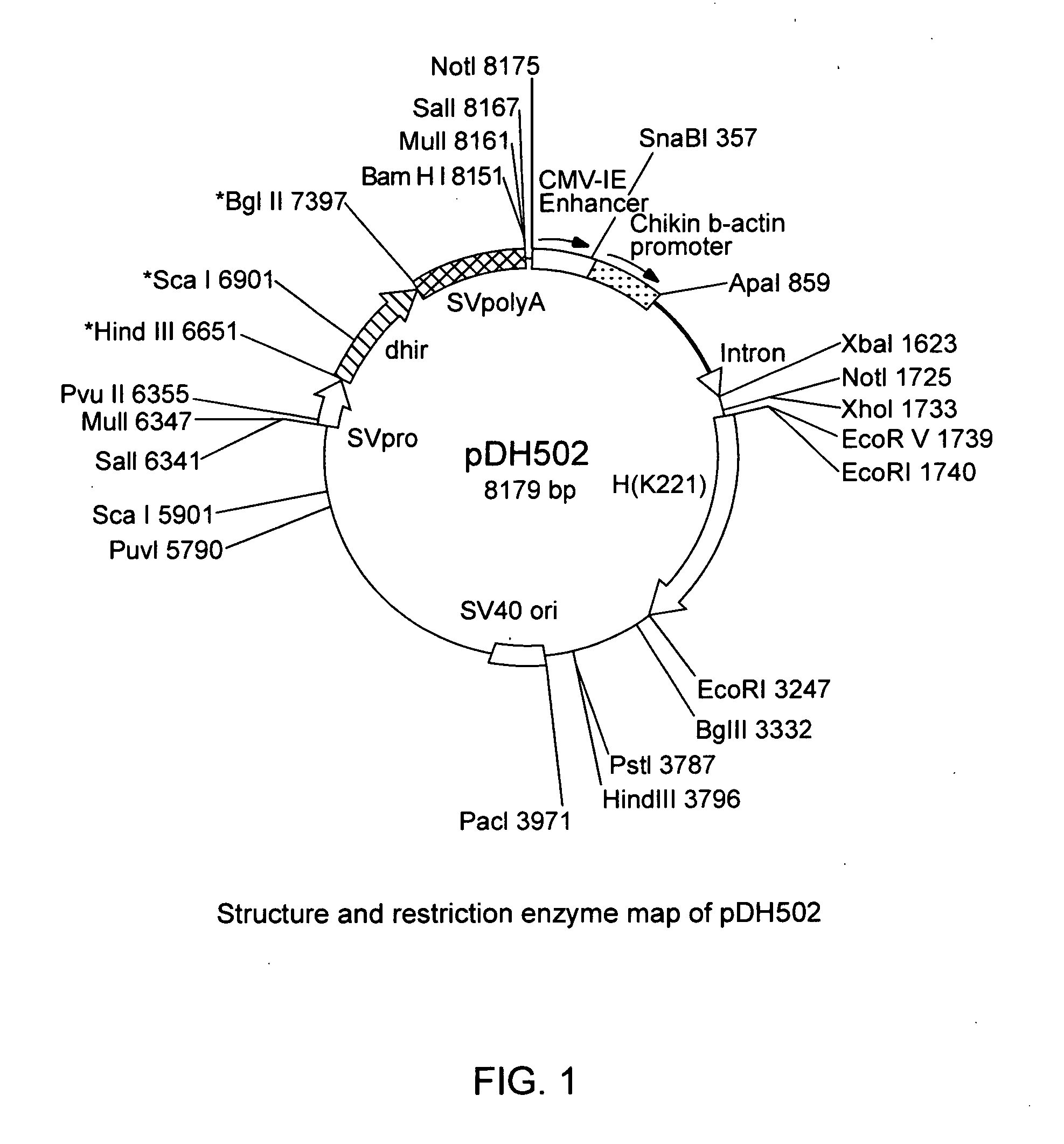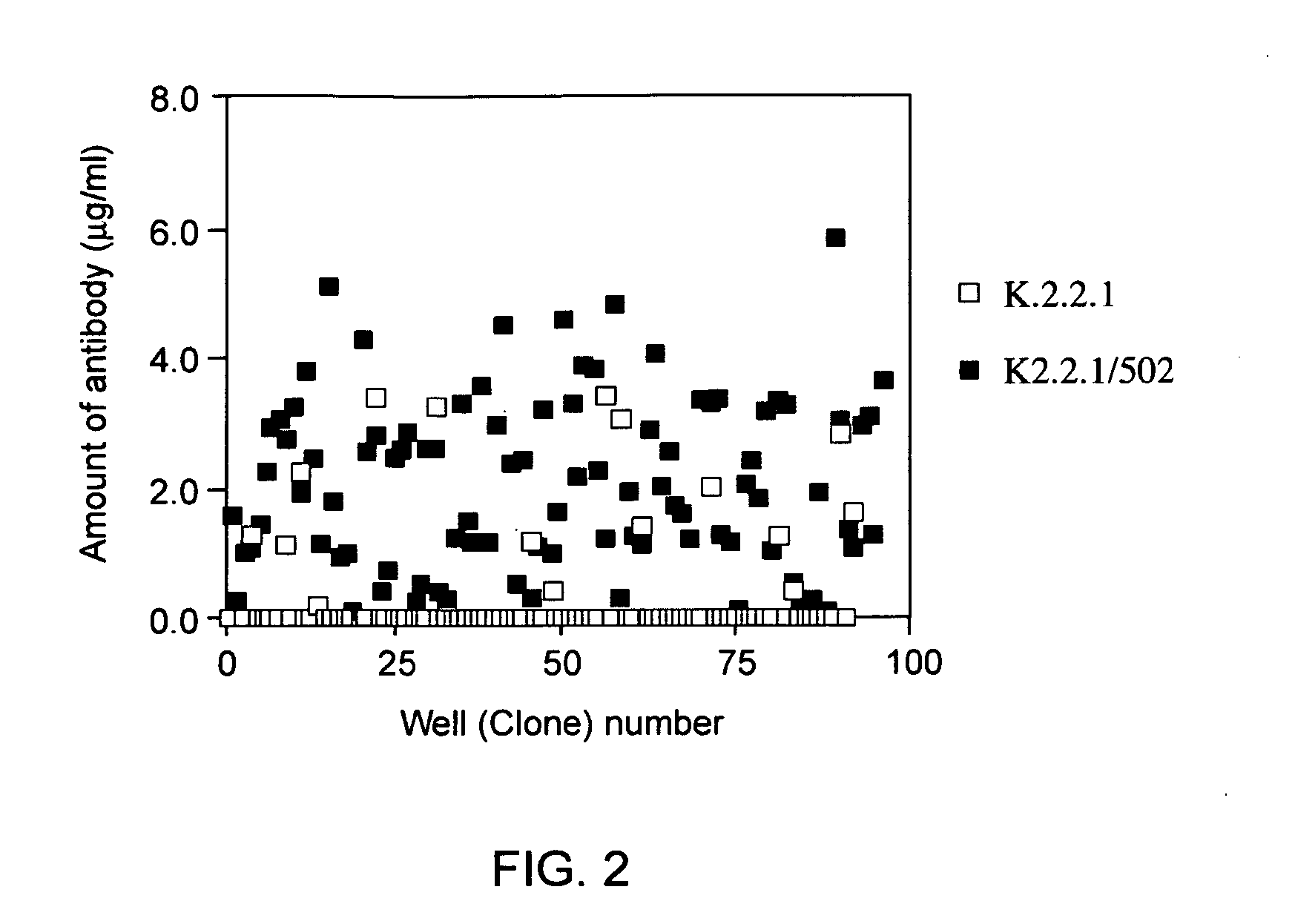Method for preparing monoclonal antibody
a monoclonal antibody and antibody technology, applied in the field of monoclonal antibody preparation, can solve the problems of insufficient mass-production of desired monoclonal antibody, inability to isolate a single type of antibody molecule comprising specificity to a specific antigen, and inability to achieve monoclonal antibody mass-production, etc., to achieve the effect of improving the expression efficiency of monoclonal antibody and improving the productivity of monoclonal antibody producing cells
- Summary
- Abstract
- Description
- Claims
- Application Information
AI Technical Summary
Benefits of technology
Problems solved by technology
Method used
Image
Examples
example 1
Preparation of Monoclonal Antibody-Producing Hybridoma
[0132] A previously reported hybridoma producing the human monoclonal antibody against human IL-8 was used in the following experiments (Nature genetics Vol. 15, p 146-156, 1997, and WO96 / 33735).
[0133] The hybridoma was produced as follows:
[0134] A previously reported transgenic mouse producing human IgG2 / κ monoclonal antibody, which was prepared by inactivating each of the endogenous locus for mouse heavy and light chain and inserting DNA comprising each locus for heavy (Cμ and Cγ2) and light chain (κ) of human immunoglobulin into mouse endogenous genome, was used as the animal to be immunized (Nature Genetics, Vol. 15, p. 146-156, 1997; Nature Genetics, Vol. 7, p. 13-21, 1994; Published Japanese Translation of International Patent Application No. Hei 4-504365; WO94 / 25585; Nikkei Science, Issue of June, p. 40-50, 1995; Nature, Vol. 368, p. 856-859, 1994; and Published Japanese Translation of International Patent Application N...
example 2
Isolation of Endogenous IgH Gene from Monoclonal Antibody-Producing Hybridoma
[0138] Frozen cells of anti-human IL-8 human IgG2 / κ monoclonal antibody-producing hybridoma (clone: K2.2.1) prepared in the above manner were dissolved in a lysis buffer and disrupted by POLYTRON and solubilized.
[0139] PolyA+ RNA was extracted and purified from the solubilized cell mixture using a commercial RNA extraction kit (Fast Track 2.0 Kit (INVITRIGEN)).
[0140] The solubilized cell mixture was incubated at 45° C., Oligo (dT) cellulose was added thereto, and gently shaken for about 1 hr. Oligo (dT) cellulose was washed and PolyA+ RNA was eluted by the elution buffer. The eluted PolyA+ RNA was precipitated with ethanol and dissolved in Tris-EDTA buffer. The concentration of the obtained PolyA+ RNA was determined by measuring absorbance at the wavelength of 260 nm.
[0141] According to the standard manner, cDNA was synthesized by conducting RACE-PCR using the obtained PolyA+ RNA as the template and the...
example 3
Introduction of IgH cDNA into Hybridoma K.2.2.1 and Preparation of the Monoclonal Antibody by Recombinant Hybridoma
[0145] The cDNA encoding the full length heavy chain for anti-human IL-8 human monoclonal antibody secreted by the hybridoma K.2.2.1 obtained above (SEQ ID NO: 1) was inserted into an EcoRI restriction site of plasmid pLS407 comprising CMV enhancer / chicken β actin promoter and DHFR gene and ligated to prepare the expression vector pDH502 according to the standard method (FIG. 1).
[0146] As the DHFR gene works as both a marker gene and a gene-amplification gene, when this gene is present, the selection of transformants by the expression vector can be done by culturing the cells in the presence of methotrexate (MTX).
[0147] The IgH gene expression vector pDH502 was introduced into hybridoma K. 2.2.1 by electroporation. The hybridoma was cultured in a selection medium (IMDM (JRH BIOSCIENCE) containing 10% FBS and 300 mM MTX), and about one hundred grown transformants (rec...
PUM
| Property | Measurement | Unit |
|---|---|---|
| temperature | aaaaa | aaaaa |
| wave length | aaaaa | aaaaa |
| pH | aaaaa | aaaaa |
Abstract
Description
Claims
Application Information
 Login to View More
Login to View More - R&D
- Intellectual Property
- Life Sciences
- Materials
- Tech Scout
- Unparalleled Data Quality
- Higher Quality Content
- 60% Fewer Hallucinations
Browse by: Latest US Patents, China's latest patents, Technical Efficacy Thesaurus, Application Domain, Technology Topic, Popular Technical Reports.
© 2025 PatSnap. All rights reserved.Legal|Privacy policy|Modern Slavery Act Transparency Statement|Sitemap|About US| Contact US: help@patsnap.com


